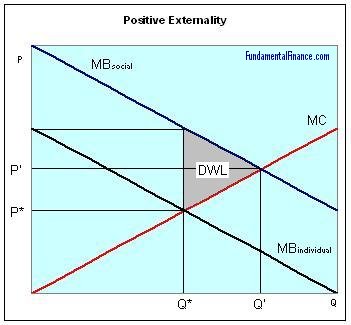Positive Externality
A positive externality exists when an individual or firm making a decision does not receive the full benefit of the decision. The benefit to the individual or firm is less than the benefit to society. Thus when a positive externality exists in an unregulated market, the marginal benefit curve (the demand curve) of the individual making the decision is less than the marginal benefit curve to society. With positive externalities, less is produced and consumed than the socially optimal level.
 When a positive externality exists in an unregulated market, consumers pay a lower price and consume less quantity than the socially efficient outcome. This can be seen on the graph. Consumers pay price P' and consume quantity Q', but at that quantity society would have them pay more. At P' Q' the marginal benefit to society is much higher than marginal cost, resulting in a deadweight welfare loss. The socially efficient outcome is to pay price P* and consume quantity Q*. At this price and quantity the marginal benefit to society is equal to the marginal cost.
When a positive externality exists in an unregulated market, consumers pay a lower price and consume less quantity than the socially efficient outcome. This can be seen on the graph. Consumers pay price P' and consume quantity Q', but at that quantity society would have them pay more. At P' Q' the marginal benefit to society is much higher than marginal cost, resulting in a deadweight welfare loss. The socially efficient outcome is to pay price P* and consume quantity Q*. At this price and quantity the marginal benefit to society is equal to the marginal cost.
There are many Common examples of a positive externality. Immunization prevents an individual from getting a disease, but has the positive effect of the individual not being able to spread the disease to others. Keeping your yard well maintained helps your house's value and also helps the value of your neighbors' homes. Beekeepers can collect honey from their hives, but the bees will also pollinate surrounding fields and thus aid farmers.
Solving the Positive Externality Problem
In order to get consumers to consume more of a good that has a positive externality, a subsidy can be given to them. The subsidy will increase the marginal benefit they receive when they consume the good. The subsidy can be payed for by all those who receive the external benefits.
by B. Taylor, 2006
|